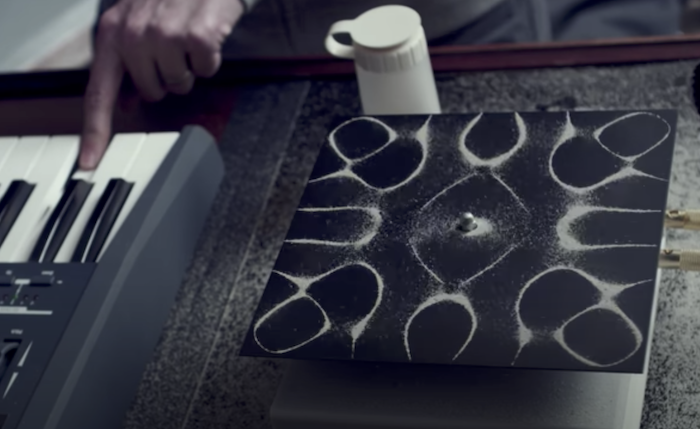Sound plays a much larger role in the ebb and flow of life on our planet than most people fully appreciate.
More specifically, sounds warn, inform and guide us, trigger emotions and help us make better sense of the world around us and our place in the order of things.
The mysteries and wonders of the spectrums of sound generally intrigues us.
From loving warbles of a morning dove at the first light of dawn to the golden silence of a summer afternoon breeze to the ferocious crackles of thunder to the plip-plop of the falling rain, sounds fill our lives.
One of the most exciting and beautiful expressions of sound is found within the scientific artform of cymatics.
Cymatics was first documented in the 1880s by German physicist and musician Ernst Chladni. He demonstrated the process of using sound vibrations via varying frequencies to manifest geometeric patterns of sand.
Chlandi took a metal plate, spread sand along the top and then ran a violin bow on the edges. As he did this, the sand settled into distinct geometric patterns, depending on the frequencies of the sound waves.
No magic tricks. No hoaxing. Simply a mystery of science.
Later, during the 1960’s, Swiss physician Hans Jenny expanded upon Chladni’s experiments, delving into the study of vibrational phenomena and coining the term “cymatics”.
Then, visual artist Jeff Louviere stumbled upon the works of Jenny and Chladni. Intrigued, he and his partner, photographer Vanessa Brown, conducted a series of experiments exploring the visual manifestations of sound on matter.
Their endeavors culminated in the production of Resonantia (‘echo’ in Latin), a multimedia project featuring a dozen images generated by the cymatics process.
Importantly, it is not necessary to be a scientist to experiment with cymatics. Cymatics is able to be tested by anyone.
By using a metal plate with tiny piles of sand on it, hooked up to a machine that transmits sound, this YouTuber was able to demonstrate that different frequencies caused the sand grains to form their own unique, and consistent, geometrics patterns, as demonstrated in the video below.
The question that cannot be overlooked is: how do the grains of sand ‘know’ how to formulate into unique patterns based on the type of sound waves being received? It doesn’t matter who or where you are in the world, when conducted properly, the same geometric patterns correspond to a specific frequency.
Is this the language, the expression, of God? What else in our known existence could be instructing these sand grains to work together to form specific and perfect geometric patterns?
In essence, each individual grain of sand is a receiver and performs a function in unison with neighboring grains of sand depending on which frequency is presented.
Are the sand grains, somehow, one collective consciousness working together in some mysterious way that humans are unable to comprehend the reason, yet see clearly the end result?
How else is this amazing behavior of Nature possible? The metal plate is simply a conduit, essentially the transmitter of the message.
The images themselves are a creative example of physics at work. “It’s kind of a classic demonstration in acoustics,” says Trevor Cox, a professor of acoustic engineering at the University of Salford in England. “These are actual physical patterns.”
Every object has a characteristic frequency, or frequencies, at which it vibrates most, with the least input of energy. Those vibrations are associated with standing wave patterns called modes.
“What’s happening is, the sand is moving away from the bits [on the plate] where it’s vibrating a lot” says Cox, and it’s settling in places where there are no vibrations (these places are called “nodes”). And, “if you up the frequency, you’ll find the patterns get really complicated,” because more of those nodes occur.
All sounds on Earth are pressurized acoustic vibrations, or disturbances, in and through either a liquid (water), gas (air) or solid form, and as a result, manifest into different and specific sound wave patterns that affect everything else within their reach.
Regardless of how technical the actual science and mathematics behind cymatics are, it remains a challenge to apply an everyday explanation and logic to this wonderfully beautiful enigma of the world around us.
